Biodiversity enables human life; it is imperative that all of humanity reconnects with what sustains the ability of our species to persist.
Marc Bekoff
09 January, 2025
Las Cruces Biological Station, San Vito
This was a day to stay in one place and enjoy the inestimable splendour of this fabulous spot; jointly known as the Wilson Botanical Gardens.
Even before breakfast we were out on the deck, greeting the day along with the birds. If I understand it correctly the biological station has ceased its practice of feeding the birds, as a philosophical measure rather than a cost improvement, but seems to have no objection to visitors continuing the practice. Carlos had bought bananas and we wasted no time deploying them.
The view of the grounds was lovely.
Grey-headed Chachalacas (Ortalis cinereiceps), accustomed no doubt to this early morning ritual, were waiting patiently for breakfast to be delivered.
Their large size and relatively aggressive nature enables them to dominate the food, but they were an exotic addition to our bird list, and we welcomed their presence.
Breaking up the bananas and spreading them around mitigated their depredations somewhat. Once in a while someone would attempt to chase them off but they returned before your back was turned.
It's their country after all. We were merely guests.
A Red-tailed Squirrel (Sciurus granatensis) had more success holding its own against the chachalacas than small songbirds.
This member of the tribe Ingeae is exceptionally attractive, wispy and delicate, like a glowing debutante at the spring ball.
As tanagers go, Palm Tanager (Thraupis palmarum) is quite subdued, but does not in any way lack charm.
After breakfast we were joined by Jason, a local naturalist and guide, with intimate knowledge of Las Cruces, for an intensive tour of the property.
Before leaving on our walk he provided us with information on the origins of the biological station, the gardens, and the ongoing role of the institution in the education of young biologists.
We benefitted greatly from time spent with Jason.
One of the first gems he was able to show us was a White-crested Coquette (Lophornis adorabilis), a dazzler even among hummingbirds.
We were all on a high simply from being in this magical place, and our euphoria was magnified by the sighting of this elusive bird. Normally seen zooming by at high speed, this very considerate male actually perched and posed for us.
There are many cavity nesters among tropical birds, and nest holes are at a premium and highly contested.
We were an eager group, stopping to look at everything, with questions about every little detail - the eager attention of naturalists on full display.
Central American Agouti (Dasyprocta punctata) is a common rodent, quickly becoming accustomed to humans.
Whether we would have seen this treasure without Jason's familiarity with the area is open to question, but I was thrilled to see my first stingless bees in Complex Terragonisca angustula.
This eusocial bee lives in above ground cavities, with colonies sometimes reaching 10,000 individuals. The entrance to the colony is a wax tube, guarded by bees which are substantially heavier and larger than forager bees.
We may be birders first and foremost but these wonders of nature excite us too. The endeavours of bees were on full display.
Bougainvilleas (genus Bougainvillea) manifest themselves in many forms - all exquisite.
Jason had yet another surprise for us up his sleeve. In addition to seeing the male White-crested Coquette he knew the location of a nest, with the female incubating eggs.
Highly promiscuous male hummingbirds take no part in the raising of the young, so it's impossible to know whether the male we saw earlier is the father here.
No doubt you are admiring, as we did, the intricate structure of the nest, constructed primarily of lichens and bound with spider webs, a marvel of design and execution.
This plant, I believe, is known as Queen's Wreath (Petrea volubilis).
This flower verges on the phantasmagorical, but it is known as Winged-stem Passion Flower (Passiflora alata), a feast for the eyes to be sure.
Cosmos (genus Cosmos)
Ginger comes in many forms; new to me was Spiral Ginger (genus Costus).
It was a stingless bee day, and I was enthusiastic about seeing new species, but this one is proving to be a bit of a puzzle.
I believe that it is in the genus Trigona. Bees in this genus are also known as Underground Vulture Bees, living in eusocial colonies. However, based on the information I have gleaned from the literature it is found in South America only, with none of the range maps indicating a presence in Central America.
Furthermore, according to The Lives of Bees, Grozinger & Patch (2024), 'These bees have never been observed to visit flowers..."
Our pictures belie this statement.
I have posted images to the internet platform iNaturalist and there are two independent confirmations that it is indeed Trigona.
Carlos showed us a type of seed that is dried and placed in a gourd to make a traditional maracas.
Hooray, yet another stingless bee to fuel my curiosity and enthusiasm! This species (genus Lestrimelitta) is also known as a robber bee.
They readily attack small or weak honey bee colonies, overwhelming the host species with chemical repellents.
Miriam took what I believe to be a remarkable series of images of the metamorphosis of White-tipped Cycadian (Eumaeus godartii), from caterpillar, to chrysalis, and in the final picture a butterfly emerging.
This species is primarily a scavenger, especially on road kill, but also eats insects, crabs, frogs and toads, as well as some vegetable matter, so the garden would likely be a fertile hunting ground.
Jason kept delivering for us. He took us just beyond the gates onto the edge of the road where a Long-billed Starthroat (Heliomaster longirostris) had built its nest in the unlikely location of a cable above the busy thoroughfare.
Never before have I seen the nests of two species of hummingbird on the same day.
Back in the gardens we took special delight in a daytime roost of Thomas's Fruit-eating Bat (Dermanura watsoni).
This beautiful flower is a Peace Lily (genus Spathiphyllum) and it seemed that it was emitting an odour that pleased the nose.
Tina (the Blue-backed Sniffer) and Kuldip (The Sommelier of the Flora) could not resist getting a little closer.
A pair of White-crowned Parrots seemed to be searching for a suitable cavity in which to start a family.
Here you see the very attractive flowering stage of the fruiting tree commonly known as Cow Okra (genus Parmentiera).
It is redundant to say that orchids are beautiful, but Cyrtochiloides ochmatochila ratchets up beauty even higher.
Miconia trinervia is a small tropical shrub or tree but I have been unable to find out much more about it. I am also curious as to the insect that destroyed the leaf so thoroughly, but again I have drawn a blank when seeking information.
A Squirrel Cuckoo (Piaya cayana) was reluctant to display its whole body, always remaining partly hidden by foliage.
Based on many conversations over many years, it is clear that toucans and aracaris are highly desired by first-time visitors to the neotropics. They are unique in so many ways and seem to reinforce the very notion of exoticism.
None fit the bill so well as Fiery-billed Aracari (Pteroglossus frantzii).
You might conjecture that its huge bill would be an inconvenience, or even impair its mobility and dexterity. Nothing could be further from the truth, however, as it picks off a berry with the precision of a surgeon.
We observed this attractive butterfly shelter, but have no idea whether it is a functional structure or simply a piece of outdoor art.
Leafcutter ants are among the most fascinating insects of tropical rain forests; here is the entrance to the underground chamber of Hairy-headed Leafcutter Ant (Atta cephalotes).
Passion Flowers (genus Passiflora)
It was approaching noon and we returned to our rooms to get ready for lunch.
It appeared that a field trip to a wet area was in the cards for some of the students - rubber boots were lined up, waiting for a suitably sized foot to slide into them.
After lunch and a period of relaxation we joined Carlos once again to meander through other areas of the biological station.
Bamboo (subfamily Bambusoidae) probably has more uses than any other plant on Earth.
Climbing Sorrel (Begonia glabra)
In a few months Yellow-bellied Flycatcher (Empidonx flaviventris) will be returning to North America to breed.
Marian's Impatiens (Impatiens marianae)
Carpentaria Palms (Carpentaria acuminata) are native to Australia's Northern Territory, so it's probably safe to assume that these impressive trees were deliberately introduced.
We were all very excited to see a White-browed Gnatcatcher (Polioptila bilineata), a lifer for all of us.
We all climbed to the top of the tower, tall and well constructed of metal, affording an excellent view of life at treetop level.
Finsch's Parakeet (Psittacara finschi) was seen frequently, but generally in flight, so we were happy to see a few of them perched.
It was getting late and darkness comes early in Costa Rica, so we made our way back to our rooms, knowing that we had enjoyed a great day.
And tomorrow we'll do it all again!



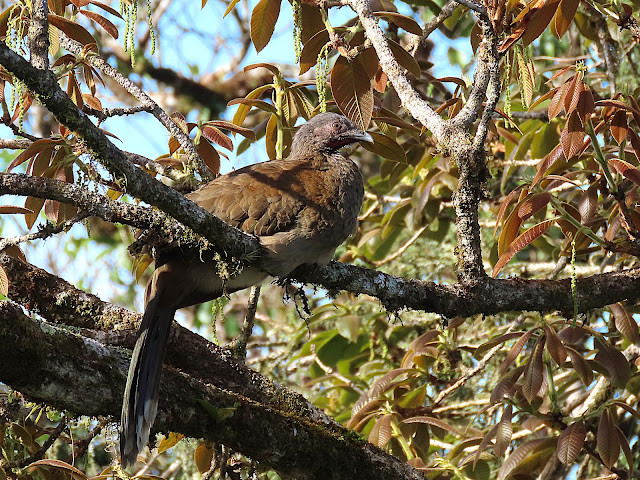



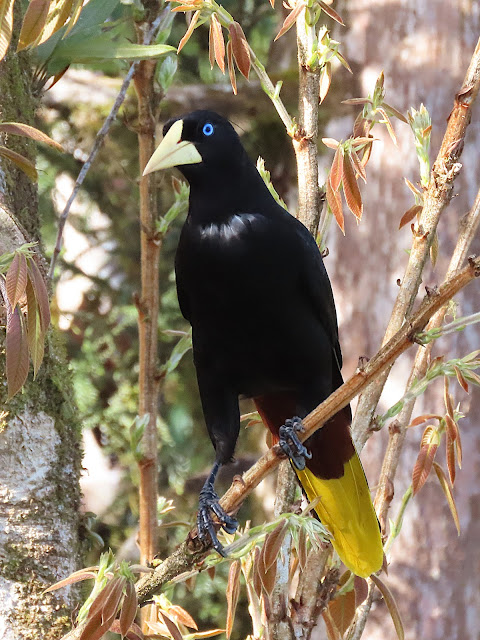



















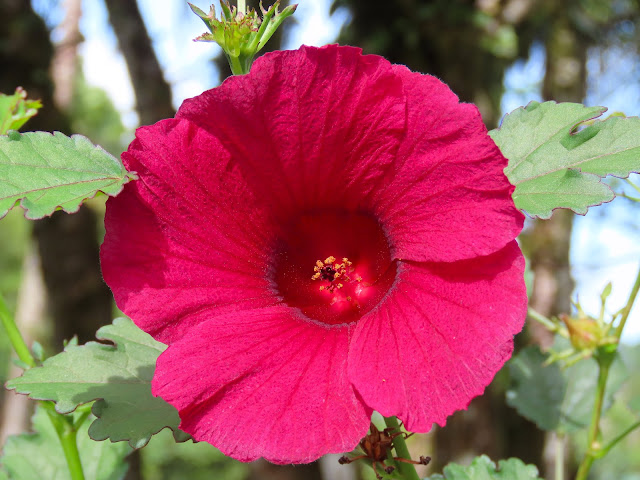



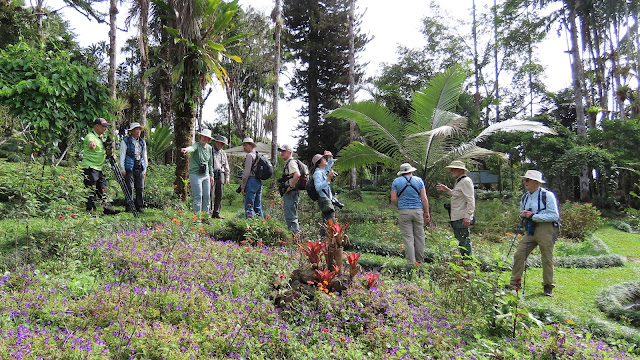
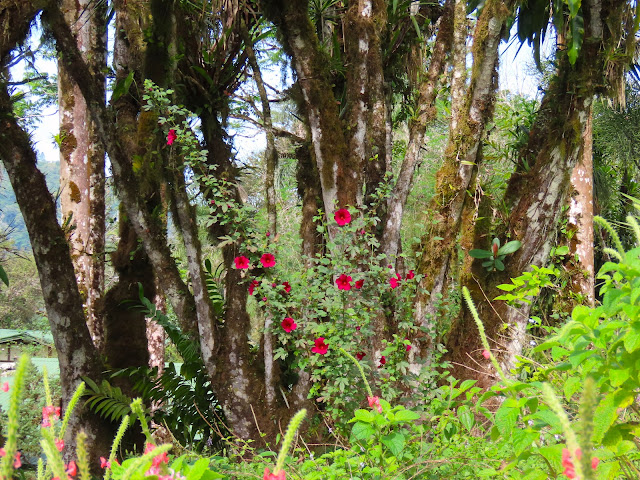














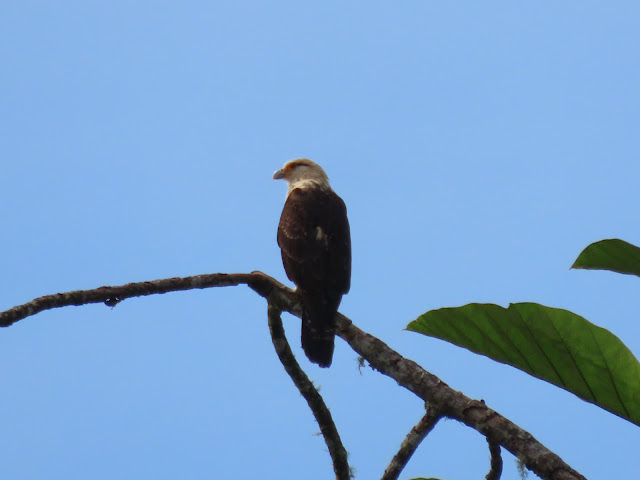









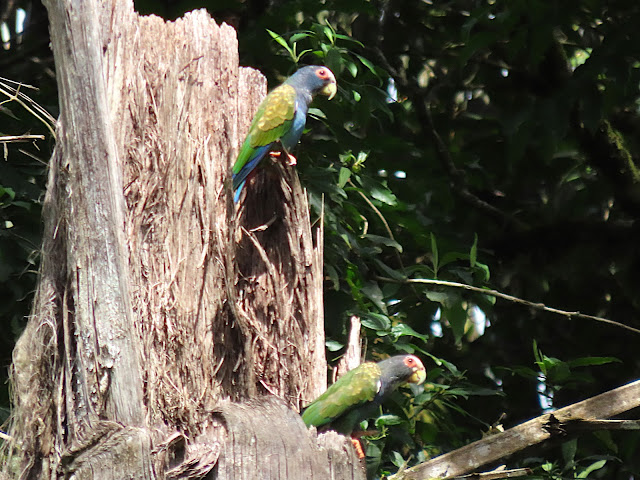





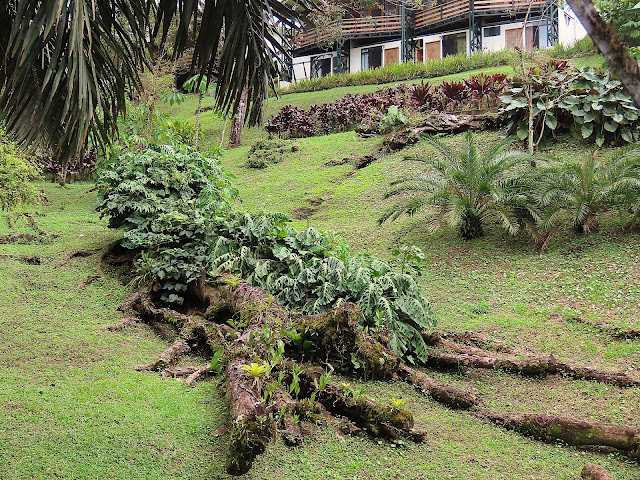
























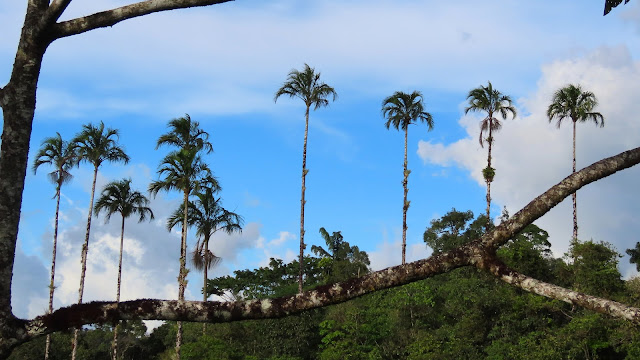

























Zachwycałam się każdym zdjęciem, każdą rośliną, każdym ptakiem i drzewem, które pokazałeś. To na pewno była niezwykła wyprawa, której Ci trochę zazdroszczę. To miejsce jest jak raj na ziemi, a Wy mogliście go oglądać i fotografować. Pięknie!
ReplyDeleteMaybe one day you will visit Costa Rica, Ludmila.
Delete...David, thanks for sharing these warming images, it has been snowing all day. A few plants I know from my Maui visits. Be warm and well.
ReplyDeleteIt’s snowing here too, Tom. I keep shovelling but I don’t know where to put it any more.
DeleteHari OM
ReplyDeleteOutstanding! No other word for it. YAM xx
What an amazing time you had at Wilson Botanical Gardens. Talk about biodiversity. I spent a lot of time reading through this post, and discovered some species I didn't know existed. And just a question out of curiosity since I'm not really familiar with Costa Rica in general, were you in an area with no scarlet macaws? I remember seeing many of them. Maybe it was just the area we were in. Have a super rest of your weekend David.
ReplyDeleteWe did see Scarlet Macaws, but not in this area down near the border with Panama. I have seen them breeding in Carara National Park in the past and it was in that general vicinity we saw them on this trip. That episode will come later.
DeleteOh, the flowers! Be still my heart. But that Aracari...you answered my immediate question, how does he manage to eat? So many spectacular sights, I would not know where to look first.
ReplyDeleteMarvelous pictures! Thank you, Miriam (I assume), for taking them and to you, David, for sharing them. As always, it is hard to pick a favorite but it might be that Spot-crowned Euphonia. What a beautiful bird!
ReplyDeleteNo need to pick a favourite. Enjoy them all.
DeleteWhat an incredible location. So much color!
ReplyDeleteA joy to see these photos of some of what you saw. Those bees are amazing as are the birds and flowers.
ReplyDeletethose birds and flowers are so amazing! I don't think I have ever seen any of them. Wish I were there to expirence all the beauties.
ReplyDeleteSuch a marvelous place! Those trees roots, which you saw along the path, are beautiful.
ReplyDeleteThe photos of the thick-billed euphonia and the red squirrel are perfect. Interesting to hear that the central american agouti is not afraid of humans. Informaton I dind't know about that common rodent.
What a great series of photos David.
ReplyDeleteSo many beautiful different types of birds and the flowers are beautiful too.
I wish you a beautiful Sunday.
Greetings Irma
So many beauty in this little country ! They are lucky !
ReplyDeleteThanks for sharing your beautiful photos David !
Have a nice week !
Anna
I have enjoyed all the pictures you show today, David. The birds and flowers are so different from what I'm used to seeing. Tropical climate is really exciting. I know a Norwegian man who grows Petrea volubilis in his greenhouse. It is a beautiful flower. Peace lily is a plant that is widely used as a houseplant here. Yes, Miriam have taken beautiful pictures of the metamorphosis of the butterfly. She must have a lot of patience. I love to see the cat too. I know why you don't like them. Here in Norway, cat owners are encouraged to keep their cats indoors. Far too many birds die every year because of cats.
ReplyDeleteHugs and kisses, Marit
It’s not that I don’t like cats, Marit. I don’t like to see them unrestrained outdoors where they kill so many birds and other creatures. Irresponsible owners are to blame, too. Hugs and kisses - David
DeleteUn paseo por la Naturaleza es muy gratificante, a lo largo del recorrido la flora y la fauna, puede ser maravillosa.
ReplyDeleteUn abrazo.
Beautiful photos of the gardens and birds ! As always a great post and trip report.
ReplyDeleteTake care, have a great week!
That thick billed euphoria (well named!) is a stunner and I'm intrigued by the mosaic plant, which is lovely. But so much to love here, including that gorgeous cat. I have to say I can see why they stop feeding the birds or they'd have to raise your room rates! (And it is winter, so plenty in the wild, I should think.) I buy Lizzie premium food and pay more for three days of bird seed than I do one month or more of cat food! Time to fill the feeders again. (I don't mind; they're lovely!)
ReplyDeleteThe bird certainly does incite euphoria, Jeanie, but the name is euphonia not euphoria!
DeleteI oood and ahhhhed and wowed at each photo, love that first bird. the only thing I recognized was a squirrel, a cat and palm trees and the white powder puff bush, my red one that is full of BEES, comes in white and they are just like yours here. I am wondering if they are the same and have different names or is they might be sisters. there is a white one that is about 25 feet tall at Jungle Gardens.. every single photo today is a feast for the eyes and a piece of natures art... a lovely place to stay and wake up to all that beauty..
ReplyDeleteAh and wow. I have been able to enjoy some amazing photos. What amazing natural beauty.
ReplyDeleteWow amazing photos
ReplyDeleteSo much unrestrained beauty. I was overwhelmed thinking what a magnificent day when you said it was all before lunch!
ReplyDeleteGreat photos again David. Those bees are gorgeous and love the close-up of them :-D And the caterpillar to butterfly amazing. The birds and nature too. Strange about the cat though, I wouldn't have expected that. I have 4 cats and they are indoor cats and would never dream of letting them out for their safety and the safety of other creatures, I know what cats are like! They are talking about banning cats from going outside in certain areas to protect the wildlife over here, as a cat and nature lover I fully agree with this mesaure. BUT if they do this for cats I would like to see them impose it on wreckless humans who destroy nature and kill the wildlife too. Sadly, there is a lot of that happening over here, it breaks my heart, it really does and these people get away with it.
ReplyDeleteReckless humans are the biggest problem of all, Ananka. And they’re not going anywhere soon, nor are they likely to ment their ways.
DeleteYou've really outdone yourself with these pictures. Oh so much color and beauty. We need it, or at least I know I do. We've been having such ugly weather. Would love to walk through that area and take it all in.
ReplyDeleteSandy's Space
Oh my! What beautiful gardens, the birds, the bees, and all of the flowers were spectacular. I kept stopping to ooh and ah over the photos. I've made note of the name and should I ever be fortunate to visit Costa Rica in the future, this will be on the list to visit.
ReplyDeleteGo to Costa Rica. It is reasonable and very friendly and you would not be spending your money to support a would-be dictator who daily trashes our country, and wants to annex us.
DeleteOnce again, these are all so incredible. I find the trees and plants so fascinating. So many different kinds of birds! I know that I only see a few species since I have lived in the Midwest all my life.
ReplyDeleteHowever, I do recall seeing different species on the Big Island and being fascinated.
Thanks for the beautiful tour.
What a beautiful Euphonia!...you had a great trip!.......Abrazotes, Marcela
ReplyDeleteSimply fabulous photographs ... I enjoyed every one of them.
ReplyDeleteAren't those tree roots amazing!
All the best Jan
The birds are amazing! Every photo in this post is a treasure. What a wonderful trip!
ReplyDeleteCall me shallow, Marie, but it even beats PEI!
DeleteOhhhh awesome! it's a pleasure to read about this very special trip, it seems like the ark of nature jaja. Magnificent report, the biodiversity that still exists is beautiful and fantastic. The commitment of the people is crucial for this to survive 💚
ReplyDeleteThanks for sharing, David
Greetings and excellent start to the week, dear friend!
Hello David,
ReplyDeletewhat a wealth of pictures, such a variety of colors, be it the birds or the nature around them, it's really beautiful to look at, plus a good guide and the pictures are first-class.
Greetings Frank
Kiitos David, kun sain olla taas kerran sinun, teidän ja ryhmänne kanssa katselemassa luonnon lajirikkautta, tällä kertaa Costa Ricassa. Se oli elämys!
ReplyDeleteSirpa
Kiitos David, kun sain olla sinun ja teidän ja koko ryhmän kanssa mielenkiintoisella matkalla Costa Ricassa. Kyllä luonto on ihmeellinen!
ReplyDeleteSirpa
It must be difficult to choose what to photograph, wherever you look there are a multitude of options.
ReplyDeleteBut it is where the mastery appears and achieves an excellent report.
If the birds are beautiful, the plants, flowers and insects are incredible. The real paradise, stingless bees...Miriam's photos of the caterpillar and becoming a butterfly are amazing
Congratulations David
Un abrazo
Oh my gosh. You got some amazing shots. So many beautiful birds and that hummer is a wonderful architect. The nest is purrfect.
ReplyDeleteThis would be my place of choice! Plants, birds, fungi, lichen - what is not to love. When I looked at the nest of the White-crested Coquette I was wondering what the nest was made of and thankfully you answered that question in the following paragraph. This is true art in my eyes. Miriam's photo sequence of the White-tipped Cycadian from caterpillar to chrysalis to butterfly is fascinating! She is such an excellent photographer. Another photo I was drawn to is the wax tube of the stingless bees. This is such a wonderful post, David, and I know that one day I have to go to Costa Rica. Big hugs - Carola
ReplyDeleteI should have asked you to join our last group. Now that would have been fun!
DeleteWow!! Where do I start??This would make a great presentation if you were doing a travelogue..
ReplyDeleteI never heard of a stingless Bee..Nice series and great pictures Miriam..Las Cruces looks lovely with much to offer..The metamorphosis of the Cycadian reminded me of the Monarchs that we watch and release most summers....also wonderful pictures..
Thanks for putting all that together and sharing with us...always informative...Hugs
There are well over 500 species of Stingless Bees.
DeleteHello David :)
ReplyDeleteYou really spoilt us this time with so many wonderful nature photos taken in the Botanical Gardens, and elsewhere, but the gardens are very special with a wide variety of beautiful flowers, impressive trees, and wild life inhabitants.The Fiery -billed Aracari is a spectacular bird, WOW! I said WOW to myself a number of times as I scrolled down! The blue eyed Crested Oropendola is a beauty. The colours of the other birds are fabulous.Congratulations on seeing a lifer David, this tiny bird is almost the same size as the fruit on the tree. I enjoyed seeing and reading about the
stingless bees, and the leaf cutter ants, the caterpillar to chrysalis photos, and actually seeing the
photo of the White-tipped Cycadiam emerging from the chrysalis.Thank you Miriam for all these outstanding images, and many thanks to you David for putting your post together in such an enjoyable way.
Hugs and kisses
Sonjia.
Costa Rica is a fabulous place to visit, Sonjia.
DeleteAmazing photos, such a pleasure to see.
ReplyDeleteWhat a fantastic trip. So many beautiful birds and plants. I loved the cute white crested Coquette's little nest. How interesting that it's held together with spider webs. Have a great week, take care.
ReplyDeleteI continue to be amazed at the diversity in CR. It seems that visiting via Spain is my best option at present!
ReplyDeleteCheers - Stewart M - Melbourne
Maybe spend a couple of days in Spain on the way. Great birding there.
DeleteDear David, it is a pleasure to follow your report and imagine myself in summer... my fantasy allows me to do this - to admire this beautiful white-headed coquette in a fluttering summer dress and sandals... I congratulate you all for being able to share this beautiful event. And you know that I will never see hummingbirds etc. in the original... so thank you very much for these beautiful photos and showing the wonderful gardens... and you can imagine that I was absolutely thrilled with the hummingbird nest - right? What a work of art!
ReplyDeleteI am intoxicated by the variety of flowers. How wonderful colors have an effect on us...
Many greetings from Europe - today in snow white and sky blue - which makes me very happy.
A hug for you and Miriam
Lots of snow here too, Viola, more than we have had in years.
DeleteHi David.
ReplyDeleteI enjoyed all the beautiful things you show.
What a beautiful country it is and what a lot of beautiful nature.
The many colorful birds are great.
Very nice that I can enjoy the beautiful nature a little bit.
Greetings from Patricia.
Seems like a pretty spectacular day!
ReplyDeleteNot bad!
DeleteImpressive! I like the way of life of bees.
ReplyDeleteSounds like a truly magical morning surrounded by nature’s finest! The way you describe the wildlife makes me feel like I’m right there with you. Those Grey-headed Chachalacas sure have personality! New post: www.melodyjacob.com
ReplyDeleteOtro reportaje genial, me ha gustado mucho. Abrazos.
ReplyDeleteHi David,
ReplyDeletethis is again a magnificent trip to Costa Rica. It's amazing what you saw on one day and in one place!! So many colorful birds and colorful flora. I loved to watch your blogs about it and can imagine Costa Rica is kind of paradise to you and all naturelovers.
Best regards, Corrie
Your Costa Rica series is amazing and I have so enjoyed all your posts. This one is particularly interesting as it goes from birds to animals and insects, not forgetting all the stunning plants and flowers as well. The eusocial bee is fascinating, wish we had them here, I react very badly to bee stings! Miriam's set of photos from caterpillar to butterfly is remarkable. Well done to you both. Cheers Diane x
ReplyDeleteHi David - I think everyone has expressed my views too - especially Diane's above ... thanks to you both - cheers Hilary
ReplyDeleteAlucinante toda la diversidad de flora y fauna que se puede ver en esta publicación, es enorme, embriagante para la mente. Un éxtasis de colores y formas
ReplyDelete